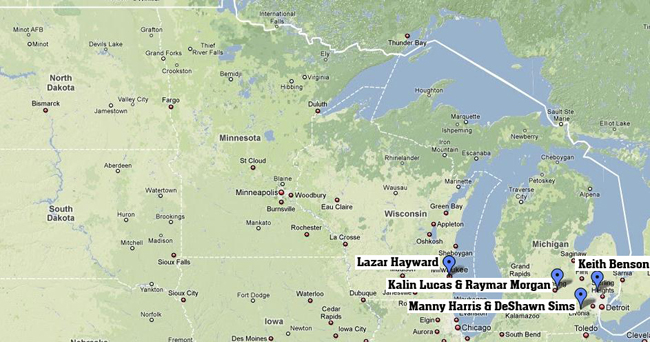RTC 2009-10 Impact Players: Upper Midwest Region
Posted by rtmsf on October 21st, 2009Ed. Note: the previous posts in this series (Northeast, Mid-Atlantic, Atlantic South, Deep South, Mid-South and Lower Midwest) are located here.
It’s time for the seventh installment of our RTC 2009-10 Impact Players series, the group of very cold, very northern states that we’re calling the Upper Midwest. Each week we’ll pick a geographic area of the country and break down the five players who we feel will have the most impact on their teams (and by the transitive property, college basketball) this season. Our criteria is once again subjective – there are so many good players in every region of the country that it’s difficult to narrow them down to only five in each – but we feel at the end of this exercise that we’ll have discussed nearly every player of major impact in the nation. Just to be fair and to make this not too high-major-centric, we’re also going to pick a mid-major impact player in each region as our sixth man. We welcome you guys, our faithful and very knowledgeable readers, to critique us in the comments where we left players off. The only request is that you provide an argument – why will your choice be more influential this season than those we chose?
Upper Midwest Region (MI, WI, MN, SD, ND)
- Manny Harris – G, Jr – Michigan. The mastermind behind the turnaround of Michigan’s basketball program may be John Beilein and his 1-3-1 zone defense, but the catalyst has to be Beilein’s explosive 6’5 scoring guard/forward, Manny Harris. The lone bright spot in a 10-22 campaign in 2007-08 was the freshman Harris and his 16.1 PPG, strong enough to garner All-Big Ten Second team honors. Much like Beilein’s other reclamation projects, the Wolverines, and Harris, improved drastically in their second season under the former West Virginia head man. While his scoring average didn’t even jump a full point, it was Harris’ all-around production and on-court leadership that propelled Michigan to a 13-3 start, respectable Big Ten record and second-round NCAA tournament appearance, their first in 11 seasons. 6.8 RPG for a 6’5 guard is an accomplishment that cannot be overstated, a mark that tied forward DeShawn Sims for the team lead. Harris led Michigan in assists by a wide margin at 4.4 APG, upped his FG% from 38% to 42% and played nearly 33 MPG to lead the Wolverines. Harris has also become a much more efficient playmaker for Beilein, increasing his assist and scoring rates (even while attempting and making over 20% of Michigan’s shots) while his turnovers have dipped. One area where Harris must improve is outside shooting, which jumped from 32% to 33% behind the arc a year ago. With Harris’ tremendous penetration ability and explosiveness to the rim, making opposing defenses respect his outside shot will only enhance an already lethal game. The All-Big Ten first teamer is the straw that stirs the Michigan drink, having started 67 games in a row for Beilein. Should he improve his defense, Harris’ draft stock will shoot up in a season that could be full of accolades, and, for the first time since the Steve Fisher era of the 90s, a legitimate chance to lead Michigan deep into March.
- Lazar Hayward – F, Sr – Marquette. Lazar Hayward’s role on this year’s Marquette squad should not be understated. Three guards and team leaders through the Tom Crean and Buzz Williams eras – Dominic James, Jerel McNeal and Wesley Matthews – saw their illustrious college careers end in the second round last March, leaving the program in the hands of Williams’ outstanding recruiting efforts off the court and Hayward’s all-around play on the court. The 6’6 multi-dimensional forward is now the face of a proud basketball school that may take a step back this season with the losses of those three guards that starred for four full seasons in Milwaukee. But it’s unlikely that Hayward will take a step back. Often overshadowed and underappreciated, Lazar averaged 16.3 PPG and 8.6 RPG as a junior last season while shooting 36% from three and 82% from the line, offering another outside threat to go along with McNeal and Matthews. In fact, Hayward finished in the top ten in a historic Big East in scoring, rebounding and free throw percentage last year. He even refined his game on an international stage over the summer, averaging 9.3 PPG and 5.6 RPG on the bronze medal-winning USA team at the World University Games. Hayward is now the face of the Marquette program for his senior season. While the Golden Eagles could struggle, Hayward must step into the departed guards’ shoes as team leader for the junior college and freshman influx headed to the Bradley Center in 2009-10, not only to facilitate success this season, but also for the future.











































